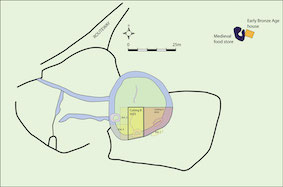2023:143 - CAHERCONNELL, Clare
County: Clare
Site name: CAHERCONNELL
Sites and Monuments Record No.: CL009-030008
Licence number: 22E0386 ext.
Author: Michelle Comber
Author/Organisation Address: Archaeology, School of Geography, Archaeology, and Irish Studies, University of Galway
Site type: Ringfort - cashel
Period/Dating: Multi-period
ITM: E 523553m, N 699437m
Latitude, Longitude (decimal degrees): 53.040127, -9.139951
Four drystone enclosures or cashels occur in the townland of Caherconnell in the Burren, Co. Clare. Two have already been excavated (10E119 and 10E0087), with this example situated between these two. The cashel is sub-circular and now defined by a collapsed dry stone wall of 35m maximum external diameter. Much of the stone from the cashel wall has clearly been removed and ‘recycled’, for use either in later enclosures or field walls. Its entrance faces southeast. Excavation is by the Caherconnell Archaeology Field School.
The 2023 primary target (Cutting B: 14m x 8m) is a cutting located in the southern half of the cashel interior. It was designed to explore the cashel interior and a couple of visible features: a length of wall and a potentially late hut-like structure. The cutting was extended (the extension referred to as Cutting B.1) into the south-west corner of this non-circular cashel. Within the cashel wall, this measured 6m north-south by 7.55m.
Eight main archaeological phases have been identified. These phases date to the Early Bronze Age, c.2210 BC, as-yet undated ‘pre-cashel’, early medieval (c.800 AD), medieval, post-medieval, and modern. It is envisaged that further relative dating (artefact typology) and absolute dating (radiocarbon) will facilitate refinement of this stratigraphic sequence.
Phase 1 is represented by a spread of prehistoric material. In Cutting B/B.1, the scatter of prehistoric artefacts (lithics and a few small pot sherds) was less dense than that found in 2022, reflecting a growing distance from the core of the knapping work, and later erosion and deliberate disturbance of early layers.
Phase 2 evidence comprised a revetted cairn deliberately incorporated into the circuit of the later cashel.
Phase 3 comprises the cashel itself and stratigraphically associated layers and features. The enclosure appears to be an early medieval cashel, complete with double-faced wall, stone foundation, and south-eastern entrance. Activity in Cutting B is represented by the outline of a circular structure. Finds included part of a shale finger ring and an iron ringed pin.
Phase 4 saw the end of primary use of the cashel, the interior abandoned whilst portable stones were robbed for use in the late 10th-century construction of Caherconnell cashel, 50m upslope. A natural soil accumulation occurred after the stone removal, though this appears to coincide with periods of weathering and erosion, resulting in the patchy survival of such contexts.
Overflow of activity in the adjacent Caherconnell cashel (10E0087) explains medieval re-use of the then-lowered, abandoned, and weathered cashel enclosure in Phase 5. A relatively level and sheltered area in the southwest of the interior was further levelled. An outdoor hearth was constructed on top of this, while metalworking seems to have taken place close by. Medieval occupation/activity layers accumulated around these. Finds included bronze stick pins and a silver coin.
Another period of abandonment marks Phase 6. Weathering and erosion of exposed surfaces occurred again, with the remaining upper courses of the inner face of the cashel wall collapsing into the interior of the enclosure along the east and south. The duration of this abandonment is unknown, however renewed use of the enclosure after this period of time represents post-medieval Phase 7. A small enclosure possibly related to animal management was built on top of the remaining wall and its adjacent tumble. A slab wall was built running north from this, along the top of the earlier levelling revetment, with some evidence of activity in the south-west corner as well (some clearance and slab laying). Finds included a bone button and bronze buckle.
The final phase of activity, Phase 8, brings the story of this site into the modern era. The Phase 7 structure may have seen some use, but rather quickly collapsed. A smaller enclosure, only suitable for a single mature animal or a small number of young animals, was built next to it. The stones of the top of the cashel wall were rearranged to form a higher, thinner wall along its outer edge, making the cashel a usable animal enclosure/small field.


